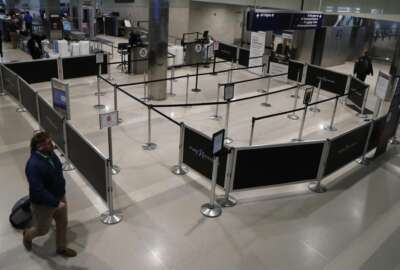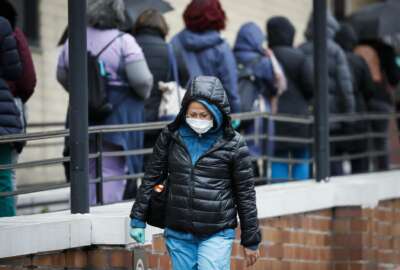
Hubbard Radio Washington DC, LLC. All rights reserved. This website is not intended for users located within the European Economic Area.
Hubbard Radio Washington DC, LLC. All rights reserved. This website is not intended for users located within the European Economic Area.
Housing and Urban Development and Small Business Administration -- have become first responders. First economic responders, thanks to the series of money-printi...
Best listening experience is on Chrome, Firefox or Safari. Subscribe to Federal Drive’s daily audio interviews on Apple Podcasts or PodcastOne.
As they were in the 2008 collapse, largely financial agencies — Housing and Urban Development and Small Business Administration — have become first responders. First economic responders, thanks to the series of money-printing bills Congress is passing. For some insight on how they might cope, former HUD chief financial officer, now managing director for the public sector at Grant Thornton, Doug Criscitello joined Federal Drive with Tom Temin.
Interview transcript:
Tom Temin: As they were in the 2008 collapse, largely financial agencies, Housing and Urban Development and the Small Business Administration have become first responders. First economic responders. Thanks to that series of money printing bills Congress has been passing joining me with some insight on how they might be coping former HUD chief financial officer who is now Managing Director for the public sector at Grant Thornton, Doug Criscitello. Hello, Doug, good to have you back.
Doug Criscitello: Hey, great to be here. Tom.
Tom Temin: Give us a sense of the scope of the activity that HUD and especially SBA are under right now in terms of just the sheer volume of work that this is producing for them.
Doug Criscitello: Well, the Small Business Administration is really on the front lines of providing assistance in the midst of this pandemic. And the magnitude of the assistance being pushed out is just unprecedented. SBA is going to do about $700 billion in lending under its Paycheck Protection Program. That’s equivalent to an amount that SBA will originate typically in about 25 years, and they’re doing it in one month. So the crush of work at SBA is far greater than it’s ever been.
Tom Temin: And in the CARES Act, I believe, either that bill or the bill immediately before there were some 10s of billions of dollars for federal agencies to staff up for this, but how could they possibly staff up with enough expertise this fast to be able to do that?
Doug Criscitello: Yeah. Right. And that’s the huge challenge. I mean, one thing agencies can do relatively quickly is bring onboard contractors, but in terms of adding staff, I mean, that’s a time consuming process. So agencies that are on the frontlines right now are really struggling with the workload, and, you know, I must admit, are doing a commendable job thus far. I mean, again, going back to SBA, the fact that they stood up this program in one week and dispersed about $350 billion in two weeks is a tremendous accomplishment. Now, there will be inevitably some problems that are associated with getting money out the door that quickly but they do deserve some congratulations from moving so quickly.
Tom Temin: And the other half of this is the systems the it that is necessary for all of this to happen. HUD and SBA are not exactly known for having cutting edge digital services for what they do.
Doug Criscitello: Agreed there’s been a huge amount of pressure put on the system. But you know, I can’t imagine a system anywhere that could take an increase a surge in demand of something like 100 fold of what the system deals with normally in a given day, any system would struggle under that kind of surge. So they’ve probably taken some unfair criticisms and that, you know, when you’re testing a system, your stress test It probably is never going to go to a point where you’re saying, well, let’s test this system at 100 fold greater activity than we expect it to operate at. So it’s understandable that the systems might not have held up quite as well as one would hope. But again, they are getting the job done.
Tom Temin: And let’s talk about some of the internal processes for taking in and then accounting for this money, aside from the fact that there will be all of this external oversight apparatus and the anti fraud apparatus. Just as a former CFO, all of a sudden your agency is swamped with money almost overnight, as soon as the Treasury can make the transfers into the accounts. How do you account for it? What kind of people power do you need? And how do you know you’re even watching what’s going by beneath your feet?
Doug Criscitello: And all of that is complicated by the fact that you’re trying to get the money out quickly. Right, so you’re going to test your internal controls involving budget execution, you know, your basic rules of the road that are used within an officer, the Chief Financial Officer, how do you ensure the taxpayer dollars are protected, spend prudently. You know, I was at HUD during the aftermath of the 2008 financial crisis and I got there about a year in. And when I arrived, folks in the CFO were very proud of the fact that they had pushed lots of money out the door. And I used to muse at the time that you know, a motto an OCFO probably shouldn’t be, we spend money real fast, you know, instead, we should be focused on over the funds spent with the appropriate safeguards in place and in the current context, agencies are again facing that time pressure, but hopefully they’re being very mindful of pushing toward a linkage of, you know, cost and budget information and performance so that they’re able to demonstrate, really, ultimately to taxpayers that the funds were spent appropriately and consistent with the mandates that the agency was handed through the CARES Act.
Tom Temin: And isn’t there an element of improv in all of this because Congress is not all that prescriptive when it issues these programs and often leaves it up to the bureaucracy to figure out the specifics?
Doug Criscitello: Yeah, particularly when it comes to when there’s speed involved. You know, I think if you’re going to roll out a new program, over a number of months, you know, typically legislation is passed, you know, the agency brings it in house, they analyze it develop for regulations, put it out for public comment, share that with the folks on Capitol Hill that created the program there and there’s a lot of input provided. When a new program is created an agency is told, hey, get this money on the street in the next week. There is a lot, it’s a great way to put it, there’s a lot of improv that goes on. And cutting corners too, it’s like, you know, think creatively about what can we do to get these funds out. It’s not always consistent with best practices in terms of prudent administration of taxpayer dollars.
Tom Temin: And it seems like these particular programs are complicated by the fact that they’re not simply grants, go enjoy here’s the money hope you do well in business, but there are also requirements of preservation of payroll, for example, and I know some small businesses that aren’t even sure what they mean by that. I could get rid of this person, bring that person on as a new employee, and I still have the same net payroll at the end and I can prove and therefore becomes a grant. All of these kinds of nuances mean that once the money is out the door, the agencies job is not done. So there’s a tail to this that’s gonna almost whip around again at some point.
Doug Criscitello: Yeah, I think on the Paycheck Protection Programs specifically, I think the after the fact audit of recipients is going to identify, you know, I’m sure there will be some fraud. But I think there’s just been a lot of misunderstanding as to what exactly what the program parameters are. We’re requiring applicants for that program to self certifies that they’re eligible for the assistance they do the calculation about this their their average monthly payroll, and in the government is it for the most part working through its network is several thousand lenders across the countries, for the most part, accepting what the applicant certifies. They had some strange dynamic for a federal assistance programs that your the intended beneficiaries are certifying the relevant ability. So, you know, we don’t see that typically.
Tom Temin: And from a simple standpoint of function, you’ve also got the agency staff, mostly teleworking. And that’s got to be a complicating factor.
Doug Criscitello: It is at SBA, for instance, though, I know there are a number of staff that have been going in just given this crush of work. But yeah, it’s an additional wrinkle is that complicating matters further that, you know, agencies are not sort of operating in their standard form. So, yeah, lots swirling around here. And just, again, the magnitude of these programs, not just at SBA, but elsewhere, too. I mean, it sure does feel a whole lot like the 2008 financial crisis response, but on steroids. If you think about the size of the TARP Program, from 2008, it was 700 billion. Well, SBA alone, this small agency in the US government is going to spend 700 billion so this is a significantly larger event than what we experienced a decade ago.
Tom Temin: Doug Criscitello is former HUD Chief Financial Officer now Managing Director for the Public Sector at Grant Thornton. Thanks so much for joining me.
Doug Criscitello: Hey, great to be here, Tom.
Copyright © 2024 Federal News Network. All rights reserved. This website is not intended for users located within the European Economic Area.
Tom Temin is host of the Federal Drive and has been providing insight on federal technology and management issues for more than 30 years.
Follow @tteminWFED


